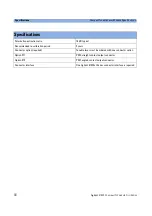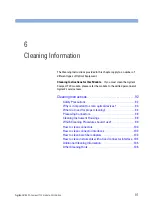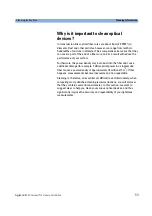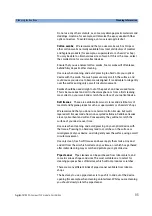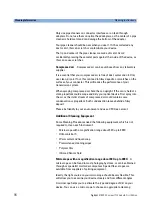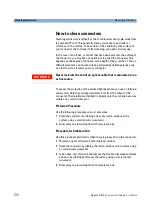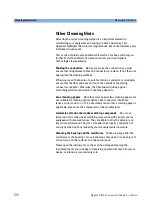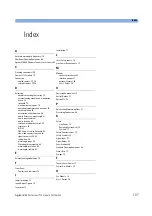
Cleaning Information
Cleaning Instructions
104
Agilent
81950A Compact TLS module, First Edition
How to clean instruments with a fixed
connector interface
You should only clean instruments with a fixed connector interface when it
is absolutely necessary. This is because it is difficult to remove any used
alcohol or filaments from the input of the optical block.
It is important, therefore, to keep dust caps on the equipment at all times,
except when your optical device is in use.
If you do discover filaments or particles, the only way to clean a fixed
connector interface and the input of the optical block is to use compressed
air.
If there are fluids or fat in the connector, please refer the instrument to the
skilled personnel of Agilent’s service team.
Only use clean, dry compressed air. Make sure that the air is free of
dust, water, and oil. If the air that you use is not clean and dry, this
can lead to filmy deposits or scratches on the surface of your
connector interface. This will degrade the performance of your
transmission system.
Never try to open the instrument and clean the optical block by
yourself, because it is easy to scratch optical components, and
cause them to be misaligned.
C A U T I O N
Summary of Contents for 81950A
Page 1: ...Agilent Technologies Agilent 81950A Compact Tunable Laser Source module User s Guide ...
Page 9: ...Agilent 81950A Compact TLS module First Edition 9 ...
Page 10: ...10 Agilent 81950A Compact TLS module First Edition ...
Page 24: ...Getting Started Signal Input and Output 24 Agilent 81950A Compact TLS module First Edition ...
Page 30: ...Accessories User s Guides 30 Agilent 81950A Compact TLS module First Edition ...
Page 50: ...Operating Instructions The User Interface 50 Agilent 81950A Compact TLS module First Edition ...

